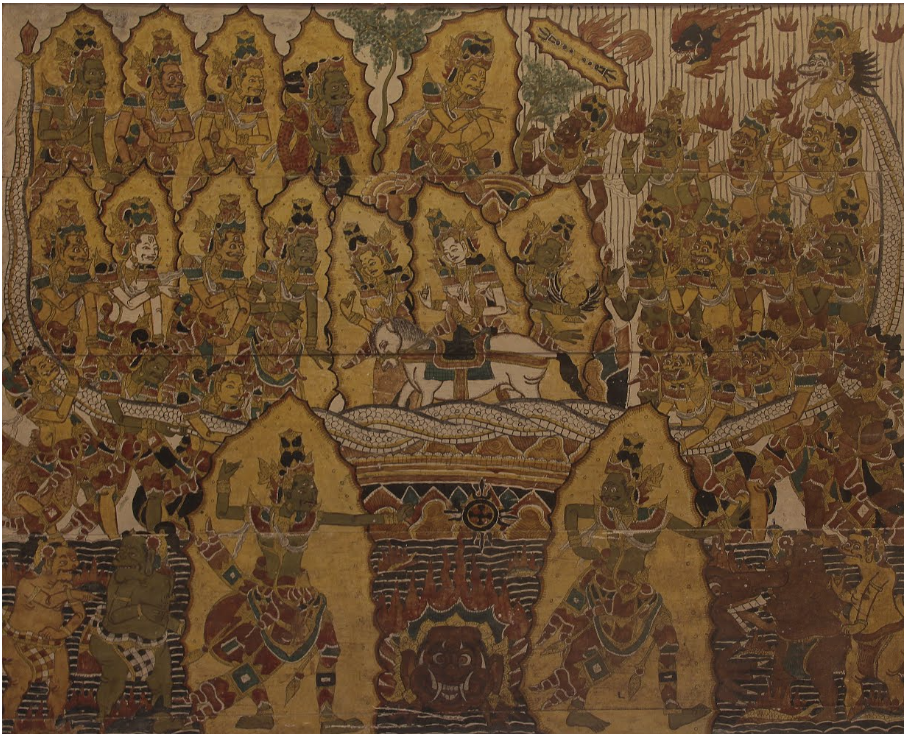
- Judul: Pemutaran Lautan Susu
- Masa Hidup Pembuat: Tahun 1920 - 1999
- Kebangsaaan Pembuat: Indonesia
- Tempat Kematian Pembuat: Kamasan, Klungkung
- Tempat Kelahiran Pembuat: Kamasan, Klungkung
- Gender Pembuat: Pria
- Tanggal: Tahun 1996 - 1996
- Pelukis: Mangku Mura
- Dimensi Fisik: lebar 142 x tinggi 114 cm
- Asal: Koleksi Mr. & Mrs. Agung Rai
- Jenis: Lukisan
- Medium: Pigmen alami di atas papan
🌟 Discover the Untold Story of Bali’s Artistic Genius! 🌟
Mangku Mura is not just a name but a symbol of the rich cultural heritage and artistic mastery embedded in Balinese tradition. As one of the most revered maestros of Kamasan painting, his work transcends mere art—it is a vibrant narrative of Bali’s spiritual and cultural identity. This report dives deep into the life, legacy, and artistic brilliance of Mangku Mura, revealing why his paintings continue to captivate art lovers and cultural historians alike. Prepare to be inspired by the story of a true Balinese legend!
🖌️ What is Kamasan Painting? A Cultural Treasure of Bali 🖌️
🌿 Origins and Significance of Kamasan Art
Kamasan painting is a traditional Balinese art form that originated in the village of Kamasan, Klungkung, Bali. Rooted in the Majapahit era (13th-16th century), this style is characterized by its intricate narrative scenes drawn from Hindu epics like the Ramayana and Mahabharata. The paintings are not just decorative; they serve as visual scriptures, preserving stories, religious teachings, and moral values.
🎨 Distinctive Features of Kamasan Paintings
- Flat, two-dimensional figures with bold outlines.
- Use of natural pigments derived from minerals and plants.
- Symbolic color schemes where each color holds spiritual meaning.
- Detailed depictions of mythological and historical scenes.
- A strict adherence to traditional iconography and composition rules.
👑 Mangku Mura: The Master Behind the Brush 👑
🧑🎨 Early Life and Artistic Journey
Mangku Mura was born in the early 20th century in Bali, into a family deeply rooted in the Kamasan painting tradition. From a young age, he was immersed in the cultural and spiritual environment of Bali, learning the sacred art from his ancestors. His dedication to mastering the traditional techniques was unparalleled, and he quickly rose to prominence as a leading figure in the Kamasan art community.
🎯 Artistic Philosophy and Style
Mangku Mura’s work is distinguished by his ability to blend strict traditionalism with subtle innovation. While he maintained the canonical rules of Kamasan painting, he introduced nuanced expressions and refined brushwork that brought a fresh vitality to the ancient art form. His paintings are celebrated for:
- Meticulous detail that captures the essence of Balinese mythology.
- Dynamic compositions that engage viewers emotionally.
- A harmonious balance between spiritual symbolism and aesthetic beauty.
🌍 Mangku Mura’s Impact on Balinese Art and Culture 🌍
🏆 Preserving Tradition in a Modernizing World
At a time when Bali was undergoing rapid social and cultural changes, Mangku Mura stood as a guardian of tradition. His commitment to preserving the Kamasan style ensured that this ancient art did not fade into obscurity. He trained numerous apprentices, passing down his knowledge and skills to future generations.
🔥 Revitalizing Interest in Kamasan Painting
Thanks to Mangku Mura’s influence, Kamasan painting experienced a renaissance in the mid-20th century. His exhibitions and collaborations with cultural institutions helped bring international attention to Balinese art. Today, his legacy inspires contemporary artists who seek to honor their heritage while exploring new creative horizons.
🖼️ Notable Works and Their Stories 🖼️
| Title of Work | Description | Cultural Significance |
|---|---|---|
| The Ramayana Battle Scene | A vivid portrayal of the epic battle between Rama and Ravana, full of dynamic action and spiritual symbolism. | Highlights the eternal struggle between good and evil. |
| The Mahabharata Assembly | Depicts the grand assembly of warriors and sages, emphasizing wisdom and valor. | Reflects Balinese values of honor and duty. |
| The Sacred Dance of Barong | Illustrates the mythical Barong dance, a symbol of protection and balance. | Celebrates Balinese ritual and community spirit. |
Each piece is a masterclass in storytelling, combining visual beauty with deep cultural meaning.
📚 Scholarly Recognition and Cultural Preservation 📚
🏛️ Museums and Archives
Mangku Mura’s works are preserved in several prestigious institutions, including:
- Museum Puri Lukisan, Ubud: Home to a significant collection of Kamasan paintings.
- Balinese Cultural Centers: Where his art is studied as part of Bali’s intangible heritage.
📖 Academic Studies
Scholars have extensively analyzed Mangku Mura’s contributions, highlighting his role in:
- Maintaining the authenticity of Kamasan painting.
- Influencing modern Balinese art movements.
- Serving as a bridge between past and present artistic expressions.
🌟 Why Mangku Mura’s Legacy Matters Today 🌟
In a globalized world, where traditional arts often struggle to survive, Mangku Mura’s story is a beacon of cultural resilience. His paintings are not just artworks; they are living testimonies of Bali’s spiritual depth and artistic genius. For art enthusiasts, historians, and cultural travelers, exploring Mangku Mura’s legacy offers a profound connection to the heart of Balinese identity.
🚀 Ready to Dive Deeper?
Explore the World of Mangku Mura! 🚀
If you’re fascinated by the magic of Kamasan painting and the genius of Mangku Mura, consider:
- Visiting Bali’s art museums to see his works firsthand.
- Learning about Balinese mythology to fully appreciate the stories behind the paintings.
- Supporting local artists who continue the Kamasan tradition today.